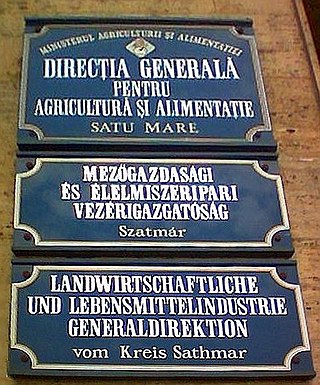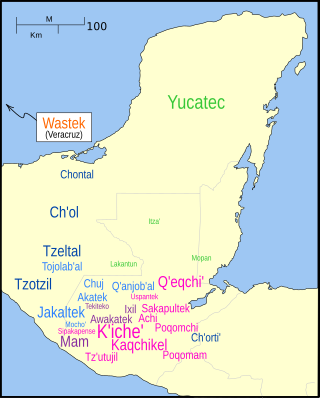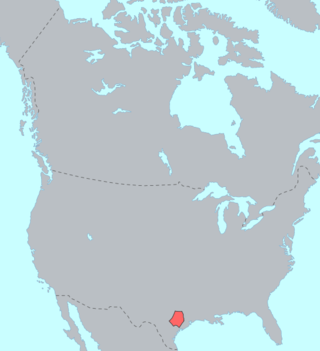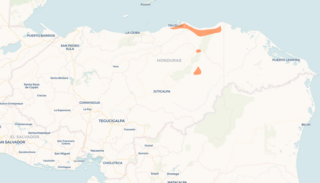Related Research Articles

Mohawk is an Iroquoian language currently spoken by around 3,500 people of the Mohawk nation, located primarily in current or former Haudenosaunee territories, predominately Canada, and to a lesser extent in the United States. The word "Mohawk" is an exonym. In the Mohawk language, the people say that they are from Kanien:ke and that they are Kanienʼkehá꞉ka "People of the Flint Stone Place" or "People of the Flint Nation".

In linguistics, agglutination is a morphological process in which words are formed by stringing together morphemes, each of which corresponds to a single syntactic feature. Languages that use agglutination widely are called agglutinative languages. For example, in the agglutinative language of Turkish, the word evlerinizden consists of the morphemes ev-ler-iniz-den, literally translated morpheme-by-morpheme as house-plural-your(plural)-from. Agglutinative languages are often contrasted with isolating languages, in which words are monomorphemic, and fusional languages, in which words can be complex, but morphemes may correspond to multiple features.

Madí—also known as Jamamadí after one of its dialects, and also Kapaná or Kanamanti (Canamanti)—is an Arawan language spoken by about 1,000 Jamamadi, Banawá, and Jarawara people scattered over Amazonas, Brazil.
Dutton Speedwords, transcribed in Speedwords as Dutton Motez, is an international auxiliary language as well as an abbreviated writing system using the English alphabet for all the languages of the world. It was devised by Reginald J. G. Dutton (1886–1970) who initially ran a shorthand college promoting Dutton Shorthand, then offered a mail order (correspondence) self-education course in Speedwords while still supporting the Dutton Shorthand. The business was continued by his daughter Elizabeth after his death.

Crow is a Missouri Valley Siouan language spoken primarily by the Crow Nation in present-day southeastern Montana. The word, Apsáalooke, translates to "children of the raven." It is one of the larger populations of American Indian languages with 2,480 speakers according to the 1990 US Census.

Tzeltal or Tseltal is a Mayan language spoken in the Mexican state of Chiapas, mostly in the municipalities of Ocosingo, Altamirano, Huixtán, Tenejapa, Yajalón, Chanal, Sitalá, Amatenango del Valle, Socoltenango, Las Rosas, Chilón, San Juan Cancuc, San Cristóbal de las Casas and Oxchuc. Tzeltal is one of many Mayan languages spoken near this eastern region of Chiapas, including Tzotzil, Chʼol, and Tojolabʼal, among others. There is also a small Tzeltal diaspora in other parts of Mexico and the United States, primarily as a result of unfavorable economic conditions in Chiapas.

Tzotzil is a Maya language spoken by the indigenous Tzotzil Maya people in the Mexican state of Chiapas. Most speakers are bilingual in Spanish as a second language. In Central Chiapas, some primary schools and a secondary school are taught in Tzotzil. Tzeltal is the most closely related language to Tzotzil and together they form a Tzeltalan sub-branch of the Mayan language family. Tzeltal, Tzotzil and Chʼol are the most widely spoken languages in Chiapas besides Spanish.
Wiyot or Soulatluk (lit. 'your jaw') is an Algic language spoken by the Wiyot people of Humboldt Bay, California. The language's last native speaker, Della Prince, died in 1962.

The Tunica or Luhchi Yoroni language is a language isolate that was spoken in the Central and Lower Mississippi Valley in the United States by Native American Tunica peoples. There are no native speakers of the Tunica language, but as of 2017, there are 32 second language speakers.

Klallam,Clallam, Ns'Klallam or S'klallam, is a Straits Salishan language that was traditionally spoken by the Klallam peoples at Becher Bay on Vancouver Island in British Columbia and across the Strait of Juan de Fuca on the north coast of the Olympic Peninsula in Washington. The last speaker of Klallam as a first language died in 2014, but there is a growing group of speakers of Klallam as a second language.

The Tonkawa language was spoken in Oklahoma, Texas, and New Mexico by the Tonkawa people. A language isolate, with no known related languages, Tonkawa has not had L1 speakers since the mid 1900s. Most Tonkawa people now only speak English, but revitalization is underway.

Quechan or Kwtsaan, also known as Yuma, is the native language of the Quechan people of southeastern California and southwestern Arizona in the Lower Colorado River Valley and Sonoran Desert. Despite its name, it is not related to the Quechua language of the Andes.
The Yimas language is spoken by the Yimas people, who populate the Sepik River Basin region of Papua New Guinea. It is spoken primarily in Yimas village, Karawari Rural LLG, East Sepik Province. It is a member of the Lower-Sepik language family. All 250-300 speakers of Yimas live in two villages along the lower reaches of the Arafundi River, which stems from a tributary of the Sepik River known as the Karawari River.
This article presents a brief overview of the grammar of the Sesotho and provides links to more detailed articles.
Bororo (Borôro), also known as Boe, is the sole surviving language of a small family believed to be part of the Macro-Gê languages. It is spoken by the Bororo, hunters and gatherers in the central Mato Grosso region of Brazil.
Hidatsa is an endangered Siouan language that is related to the Crow language. It is spoken by the Hidatsa tribe, primarily in North Dakota and South Dakota.

Pech or Pesh is a Chibchan language spoken in Honduras. It was formerly known as Paya, and continues to be referred to in this manner by several sources, though there are negative connotations associated with this term. Alternatively, it has rarely also been referred to as Seco, Bayano, Taia, Towka, and Poyuai. According to Ethnologue there were a thousand speakers in 1993. It is spoken near the north-central coast of Honduras, in the Dulce Nombre de Culmí municipality of Olancho Department.
Maia is a Papuan language spoken in the Madang Province of Papua New Guinea, and is a member of the Trans-New Guinea language family. It has a language endangerment status of 6a, which means that it is a vigorous and sustainable language spoken by all generations. According to a 2000 census, there are approximately 4,500 living speakers of the language, who are split between twenty-two villages in the Almani district of the Bogia sub-district.

Ute is a dialect of the Colorado River Numic language, spoken by the Ute people. Speakers primarily live on three reservations: Uintah-Ouray in northeastern Utah, Southern Ute in southwestern Colorado, and Ute Mountain in southwestern Colorado and southeastern Utah. Ute is part of the Numic branch of the Uto-Aztecan language family. Other dialects in this dialect chain are Chemehuevi and Southern Paiute. As of 2010, there were 1,640 speakers combined of all three dialects Colorado River Numic. Ute's parent language, Colorado River Numic, is classified as a threatened language, although there are tribally-sponsored language revitalization programs for the dialect.
Awara is one of the Finisterre languages of Papua New Guinea. It is part of a dialect chain with Wantoat, but in only 60–70% lexically similar. There are around 1900 Awara speakers that live on the southern slopes of the Finisterre Range, they live along the east and west sides of Leron River basin.
References
- ↑ Searight, Kenneth (1935). Ogden, C.K. (ed.). Sona (PDF). London: Kegan Paul, Trench, Trubner & Co., Ltd. p. 16.
- ↑ Aldrich, Robert (2002), Colonialism and Homosexuality, Routledge, pp. 279–81, ISBN 0-415-19616-7
- ↑ Hyam, Ronald (2010), Understanding the British Empire, Cambridge University Press, pp. 454–5, ISBN 978-0-521-13290-9
- 1 2 3 4 5 6 7 8 9 10 11 12 13 14 15 16 17 18 Searight, Kenneth (1935). Sona: an auxiliary neutral language. London: Kegan Paul, Trench, Trubner & Co., Ltd. p. 31.